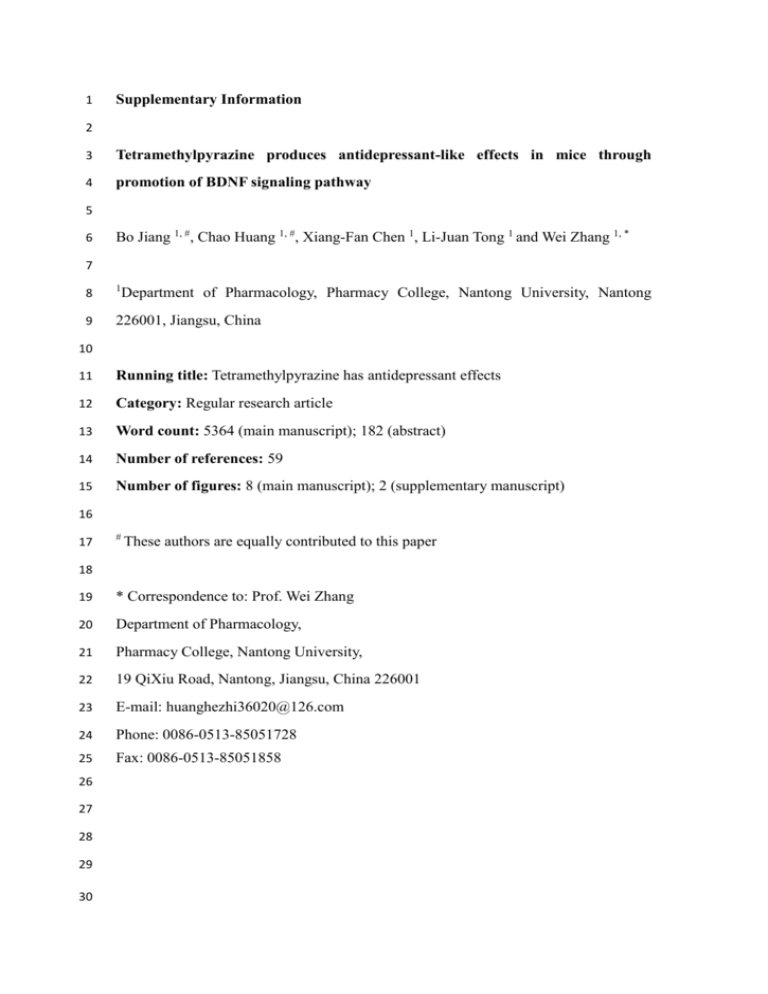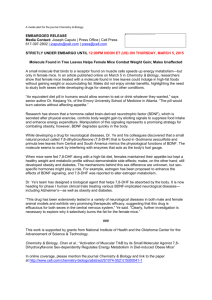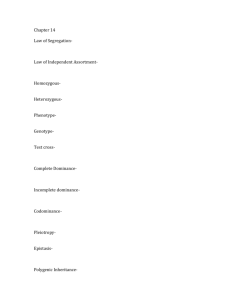Supplementary Information
advertisement

1 Supplementary Information 2 3 Tetramethylpyrazine produces antidepressant-like effects in mice through 4 promotion of BDNF signaling pathway 5 6 Bo Jiang 1, #, Chao Huang 1, #, Xiang-Fan Chen 1, Li-Juan Tong 1 and Wei Zhang 1, * 7 8 1 9 226001, Jiangsu, China Department of Pharmacology, Pharmacy College, Nantong University, Nantong 10 11 Running title: Tetramethylpyrazine has antidepressant effects 12 Category: Regular research article 13 Word count: 5364 (main manuscript); 182 (abstract) 14 Number of references: 59 15 Number of figures: 8 (main manuscript); 2 (supplementary manuscript) 16 17 # These authors are equally contributed to this paper 18 19 * Correspondence to: Prof. Wei Zhang 20 Department of Pharmacology, 21 Pharmacy College, Nantong University, 22 19 QiXiu Road, Nantong, Jiangsu, China 226001 23 E-mail: huanghezhi36020@126.com 24 Phone: 0086-0513-85051728 25 Fax: 0086-0513-85051858 26 27 28 29 30 1 Supplemental Experimental Procedures 2 Tail suspension test 3 The TST test was performed according to the methods described previously (Jiang et 4 al., 2012). Briefly, mice were suspended 50 cm above the floor for 6 min by adhesive 5 tape placed approximately 1 cm from the tip of the tail 30 min after single injection. 6 The duration of immobility was recorded during the last 4-min by an investigator 7 blind to the study. Mice were considered immobile only when they hung passively 8 and were completely motionless, and any mice that did climb their tails were removed 9 from the experimental analysis. 10 11 Open field test 12 The open field test was performed according to the methods described previously 13 (Jiang et al., 2012). The mice were placed individually in the dark in a wooden box 14 (100 × 100 × 40 cm) with the floor divided into 25 (5 × 5) squares. The apparatus was 15 illuminated with a red bulb (50 W) on the ceiling. Mice were placed in the central 16 sector 30 min after single injection, and the total number of squares entered was 17 recorded for 5 min under dim light conditions by an investigator blind to the study. 18 The open field arena was thoroughly cleaned after each trial. 19 20 Intracerebroventricular infusions of K252a and anti-BDNF-antibody 21 In this study, we blocked the BDNF-TrkB system using K252a and chicken 22 anti-BDNF antibody, which has been shown to be neutralizing and specific for BDNF 23 (Chen et al., 2005; Zhu et al., 2010). Briefly, C57BL/6J mice were anaesthetized with 24 pentobarbital sodium, and placed in a stereotaxic frame. The cannulas were implanted 25 into the left lateral brain ventricle (– 0.2 mm anterior and 1.0 mm lateral relative to 26 Bregma and 2.3 mm below the surface of the skull) (Kleinridders et al., 2009). The 27 cannula was cemented in place, and the incision was sutured. The animals were 28 allowed to recover for 3 d before the experiments started. Osmotic minipumps 29 designed to deliver 0.05 µl/min each day were filled with 50 µM K252a in ACSF/50% 1 DMSO, ACSF/50% DMSO, 20 µg/ml chicken anti-BDNF neutralizing antibody, or 2 20 µg/ml chicken IgY in ACSF (final volume, 3 µl/mouse). Each osmotic minipump 3 was attached to a brain infusion cannula. 4 5 Chronic social defeat stress 6 Social defeat and avoidance testing were performed according to our previous report 7 (Jiang et al., 2013). C57BL/6 mice were exposed to a different CD1 aggressor mouse 8 each day for 10 min over a total of 10 d. After the 10 min of contact, C57BL/6 mice 9 were separated from the aggressor: the test mice were placed in an adjacent 10 compartment of the same cage, separated by a plastic divider with holes, where they 11 were exposed to chronic stress in the form of threat for the next 24 h. Non-defeated 12 control mice were handled daily and housed opposite another C57BL/6. 24 h after the 13 last session, all the defeated mice were housed individually. After that, all the animals 14 (control mice and defeated mice) were received daily injections of vehicle/tested 15 compounds for 14 d, or intracerebroventricularly handled first and then treated with 16 vehicle/tested compounds for 14 d. 17 The day after the last injection, a two-trial social interaction test was used to assay 18 avoidance behaviors (Jiang et al., 2013). In the first 5-min trial (“target absent”), the 19 test C57BL/6 mouse was allowed to explore freely a square-shaped open-field arena 20 possessing a wire-mesh cage apposed to one side, with their movement tracked. 21 During the second 5-min trial (“target present”), the mouse was reintroduced into this 22 arena now containing an unfamiliar CD1 mouse within the cage. The duration in the 23 interaction zone were obtained using Ethovision XT (Noldus, USA) software (in 24 seconds). After each trial, the apparatus was cleaned with a solution of 70% ethanol in 25 water to remove olfactory cues. 26 Then the sucrose preference test was performed, mice were given the choice to 27 drink from two bottles in individual cages, one with 1% sucrose solution and the other 28 with water (Jiang et al., 2013). All animals were acclimatized for 2 consecutive days 29 to two-bottle choice conditions before 2 additional days of choice testing. The 30 position of the bottles was changed every 6 h to prevent possible effects of side 1 preference in drinking behavior. Before the test, animals were deprived of food and 2 water for 24 h, and were then exposed to pre-weighed bottles for 1 h with their 3 position interchanged. Sucrose preference was calculated as a percentage of the 4 consumed sucrose solution relative to the total amount of liquid intake. 5 6 Western blotting analysis 7 The experiment was conducted as we have described (Jiang et al., 2012). The test 8 mice were sacrificed 24 h after the last drug exposure. Bilateral hippocampi were 9 rapidly dissected and homogenized in lyses buffer for 30 min. The homogenate was 10 centrifuged at 12000 × g for 15 min, and supernatants were then collected. Protein 11 concentration was estimated by Coomassie blue protein-binding assay (Jiancheng 12 Institute of Biological Engineering, Nanjing, China). After denaturation, 30 μg of 13 protein samples were separated by 10% SDS/PAGE gel and then transferred to 14 nitrocellulose membranes (Bio-Rad, Hercules, CA, USA). After blocking with 5% 15 nonfat dried milk powder/Tris-buffered saline Tween-20 (TBST) for 1 h, membranes 16 were incubated overnight at 4°C with primary antibodies to extracellular 17 signal-Regulated Kinase 1/2 (ERK1/2; 1:1000), phospho-ERK1/2 (pERK1/2; 1:1000; 18 Santa Cruz, CA, USA); AKT (1:1000), phospho-AKT (pAKT; 1:1000; Cell Signaling, 19 MA, 20 phospho-CREB-ser133 (pCREB; 1:500; Cell Signaling, MA, USA); brain-derived 21 neurotrophic factor (BDNF; 1:500; Epitomics, CA, USA), GAPDH (1:1000; Santa 22 Cruz , CA, USA). The antigen-antibody complexes were visualized with goat 23 anti-rabbit or goat anti-mice horseradish peroxidase-conjugated secondary antibodies 24 (1:2000; Santa Cruz, CA, USA) by using enhanced chemiluminescence (ECL; Pierce, 25 Rockford, IL, USA). The optical density of the bands was determined using Optiquant 26 software (Packard Instruments BV, Groningen, Netherlands). USA); cAMP response element-binding protein (CREB; 1:500), 27 28 Immunohistochemical Studies 29 For hippocampal doublecortin (DCX) staining, the test mice were deeply 30 anaesthetized with pentobarbital sodium and perfused transcardially with 4% 1 paraformaldehyde in 0.01 M phposphate buffer 24 h after the last drug exposure. The 2 brains were removed and postfixed for 24 h, then dehydrated with 30% sucrose 3 solution. After that, coronal brain sections of hippocampus were cut at 25 µm with a 4 freezing microtome (CM1900, Leica Microsystems, Wetzlar, Germany) and collected 5 serially. The sections were sequentially treated with 0.3% Triton X-100 in 0.01 M 6 PBS for 30 min and 3% BSA in 0.01 M PBS for 30 min. They were then incubated 7 with diluted goat anti-DCX antibody (1:100; Cell Signaling, MA, USA) overnight at 8 4°C. The sections were subsequently exposed to fluorescenin isothiocyanate 9 (FITC)-labeled horse anti-rabbit IgG (1:50; Pierce, Rockford, IL, USA) for 1 h. They 10 were then washed in 0.01 M PBS and mounted on slides following dehydration, and 11 coverslipped. Sections were visualized with confocal laser scanning system (FV500; 12 Olympus, Tokyo, Japan). Examination of DCX-positive (DCX+) cells was confined to 13 the DG, especially in the granule cell layer (GCL), including the subgranular zone 14 (SGZ) of the hippocampus that defined as a two-cell body-wide zone along the border 15 between the GCL and the hilus. Quantifications of DCX+ cells were respectively 16 conducted from 1-in-12 series of hippocampal sections spaced at 300 μm and 17 spanning the rostrocaudal extent of the DG bilaterally. Every DCX+ cell within the 18 GCL and SGZ was counted. 19 For the NeuN+/Brdu+ double labeling, the test mice were injected with Brdu (4× 20 75 mg/kg at 2-h intervals) during the last 2 d of the 14-d drug treatment. Mice were 21 sacrificed after 4 weeks and brain sections were then produced. DNA denaturation was 22 conducted by incubation for 2 h with 50% formamide/2×SSC at 65 °C, followed by 23 30 min incubation in 2 N HCl at 37 °C, and rinsing in 0.1 M boric acid buffer (pH 8.5) 24 at room temperature. After DNA denaturation, sections were treated with 0.3% Triton 25 X-100 in 0.01 M PBS for 30 min and 3% BSA in 0.01 M PBS for 1 h, and then 26 incubated with mouse monoclonal anti-BrdU (2 µg/ml, Roche) and rabbit monoclonal 27 anti-NeuN (1:500; Abcam, Cambridge, UK) overnight at 4°C. After washing, 28 FITC-conjugated horse anti-rabbit IgG and rhodamine-conjugated goat anti-mouse 29 IgG (1:50; Pierce, Rockford, IL, USA) were applied for 1 h at room temperature. 30 Sections were then washed in 0.01 M PBS and mounted on slides following 1 dehydration, and coverslipped. Examination of NeuN+/Brdu+ co-labeling cells was 2 confined to the DG. Quantifications of NeuN+/Brdu+ cells were respectively 3 conducted from 1-in-12 series of hippocampal sections spaced at 300 μm and 4 spanning the rostrocaudal extent of the DG bilaterally. Every NeuN+/Brdu+ cell 5 within the GCL and SGZ was counted. 6 7 Supplemental References 8 Chen J, Zhang C, Jiang H, Li Y, Zhang L, Robin AKatakowski M, Lu M, Chopp M 9 (2005) Atorvastatin induction of VEGF and BDNF promotes brain plasticity after 10 stroke in mice. J Cereb Blood Flow Metab 25:281-290. 11 12 Jiang B, Wang W, Wang F, Hu ZL, Xiao JL, Yang S, Zhang J, Peng XZ, Wang 13 JH, Chen JG (2013) The stability of NR2B in the nucleus accumbens controls 14 behavioral and synaptic adaptations to chronic stress. Biol Psychiatry 74:145-155. 15 16 Jiang B, Xiong Z, Yang J, Wang W, Wang Y, Hu ZL, Wang F, Chen JG (2012) 17 Antidepressant-like effects of ginsenoside Rg1 are due to activation of the BDNF 18 signalling pathway and neurogenesis in the hippocampus. Br J Pharmacol166: 19 1872-1887. 20 21 Kleinridders A, Schenten D, Konner AC, Belgardt BF, Mauer J, Okamura 22 T, Wunderlich FT, Medzhitov R, Brüning JC (2009) MyD88 signaling in the CNS is 23 required for development of fatty acid-induced leptin resistance and diet-induced 24 obesity. Cell Metab 10:249-259. 25 26 Zhu XH, Yan HC, Zhang J, Qu HD, Qiu XS, Chen L, Li SJ, Cao X, Bean JC, Chen 27 LH, Qin XH, Liu JH, Bai XC, Mei L, Gao TM (2010) Intermittent hypoxia promotes 28 hippocampal neurogenesis and produces antidepressant-like effects in adult rats. J 29 Neurosci 30:12653-12663. 30 1 Supplemental Figure Legends 2 Supplementary Figure S1. Acute TMP treatement has no significant antidepressant 3 effects in the CSDS model of depression. C57BL/6J mice were exposed to defeat 4 stress for 10 d, and received one injection of vehicle, or TMP (10, 20 mg/kg). 5 Behavioral tests were conducted 24 h after the injection. (A) The social interaction in 6 CSDS + TMP mice was similar to that in CSDS + vehicle mice. (B) The sucrose 7 consumption in CSDS + TMP mice was also similar to that in CSDS + vehicle mice. 8 Data are expressed as means ± S.E.M. (n = 10); **P < .01; n.s., no significance. 9 Comparison was made by two-way ANOVA followed by post-hoc Bonferroni’s test. 10 11 Supplementary Figure S2. The antidepressant actions of TMP occur independent of 12 serotonergic system. (A) Depleting serotonin with the tyrosine hydroxylase inhibitor 13 PCPA before TMP administration did not eliminate the antidepressant effects of TMP 14 in the FST. (B) PCPA pretreatment had no influence on the antidepressant effects of 15 TMP in the TST. (C) CSDS-treated mice were co-injected with TMP and PCPA for 14 16 d, behavioral tests were then performed. In the sucrose preference test, TMP treatment 17 continued to produce antidepressant effects following serotonin depletion. (D) In the 18 social interaction test, mice treated with both TMP and PCPA did not differ 19 significantly from TMP-treated mice. Results are expressed as means ± S.E.M. (n = 20 10); **P < .01; n.s., no significance. Comparison was made by one-way ANOVA 21 followed by post-hoc LSD test. 22


![Historical_politcal_background_(intro)[1]](http://s2.studylib.net/store/data/005222460_1-479b8dcb7799e13bea2e28f4fa4bf82a-300x300.png)




